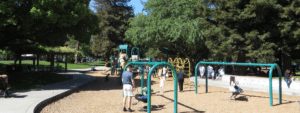Those following the conversation around increased integration of our regional governmental agencies, the Metropolitan Transportation Commission (MTC) and the Association of Bay Area Governments (ABAG), will be interested to hear that MTC just released a formal proposal for an October 28 vote to consolidate the MTC and ABAG planning departments into an Integrated Regional Planning Department under MTC’s authority.
(If you haven’t been following the conversation, we can help get you up to speed.)
Greenbelt Alliance continues to be concerned that the current proposal may not be the best way to effectively integrate the issues of issues of land use, land conservation, transportation, and social equity when planning for the Bay Area’s future. However, if the proposal does move forward, we have some suggestions for how to ensure that the integrated department addresses the multiple issues facing the Bay Area in a holistic fashion.
Below is our letter to MTC on how this can be done:
October 27, 2015
Supervisor Dave Cortese
Metropolitan Transportation Commission 101 Eighth Street
Oakland, CA 94607
RE: Proposed Functional Consolidation of Planning Departments: MTC Resolution No. 4210 Dear Chair Cortese and MTC Commissioners:
Greenbelt Alliance is the San Francisco Bay Area’s leading organization working to protect natural and agricultural landscapes from development and help our cities and towns grow in smart ways to create great neighborhoods for everyone across the income spectrum. We are the champions of the places that make the Bay Area special, with more than 10,000 supporters and a 57-year history of local and regional success.
We write to share our perspectives on the proposed consolidation of the MTC and ABAG Planning Departments into an Integrated Regional Planning Department.
The issues of land use, land conservation, transportation, and social equity are inextricably linked. The Bay Area needs a highly functional regional governance structure that effectively integrates these multiple issues to ensure the best outcomes for the region.
For years, Greenbelt Alliance has believed that the region would benefit from better integration of MTC and ABAG—including a full merger of the two agencies—to more effectively address these multiple issues. We strongly appreciate the recent attention to the topic of regional agency integration and believe it provides a unique opportunity to advance this long-sought goal.
With so much at stake, it’s essential that it’s done right.
We remain concerned that the current proposal—particularly with its short time frame and limited opportunities for public input—may not be the best way to achieve the integration across issues that many of us desire. For example, separating the staff for the Regional Housing Needs Allocation (RHNA) process from the rest of the regional planners could complicate efforts to synchronize the Bay Area’s Regional Transportation Plan / Sustainable Communities Strategy with the RHNA process, as required by SB 375. Likewise, the proposal could have unintended negative impacts on the Bay Trail program and the San Francisco Estuary Partnership.
However, should the Commission move forward and adopt a resolution to create an Integrated Regional Planning Department, it is essential that such a resolution contain language to ensure that the integrated
department addresses the multiple issues facing the region in a truly integrated fashion. The mandate of a truly integrated department will recognize that issues of housing, transportation, conservation of natural and agricultural landscapes, social equity, and economic development are all essential to planning for a vibrant, sustainable region that benefits all Bay Area residents.
MTC’s stated purpose is currently transportation-centric; the MTC website states that MTC is ‘‘the transportation planning, coordinating, and financing agency for the nine-county San Francisco Bay Area.’’ We recognize that MTC has been increasingly attentive to the intersection of transportation and these other critical issues and we appreciate that attentiveness. However, given MTC’s current transportation-focused mission we believe it is essential to articulate that an Integrated Planning Department has a broader mission. We therefore urge the Commission to add an additional ‘‘Principle’’ to Attachment A of Resolution 4210 stating that:
The mission of the integrated planning department shall be to address issues of housing, transportation, conservation of natural and agricultural landscapes, social equity, and economic development in an integrated and holistic fashion.
Finally, the resolution must include a commitment that the integration of the planning departments be developed and carried out through a transparent public process with ample opportunities for input from stakeholders and academic experts. This should include an outside assessment of the full financial implications of such a transition to ensure existing programs such as the San Francisco Estuary Partnership and Bay Trail program are not negatively impacted. We also strongly support a study to examine opportunities for deeper integration of MTC and ABAG, including full merger, and encourage MTC to identify clear, meaningful roles for the public in the design and execution of that study to ensure that we take advantage of the wealth of information and perspectives from stakeholders from across the region.
We expect to be highly engaged in future decisions about the Bay Area’s regional planning functions and remain committed to the goal of a workable regional structure that creates a better Bay Area for all.
Sincerely,
Matt Vander Sluis
Program Director
mvandersluis@greenbelt.org
CC:
Julie Pierce, ABAG Chair
Ezra Rapport, ABAG Executive Director
Miriam Chion, ABAG Planning & Research Director Steve Heminger, MTC Executive Director
Ken Kirkey, MTC Planning Director




